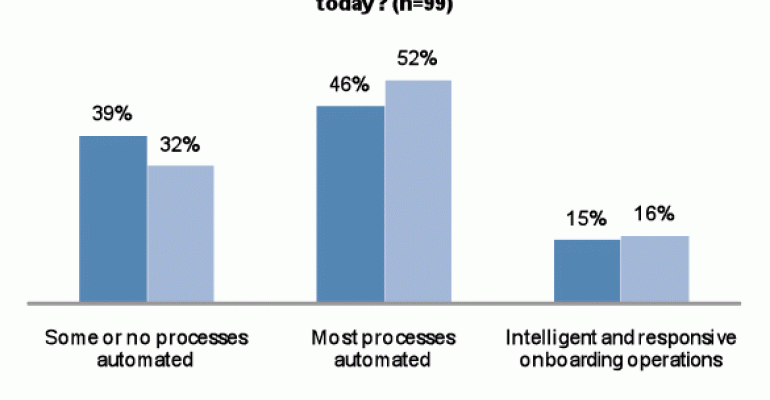U.S. wealth management firms run the risk of losing business due to poor on-boarding—the transfer of an advisor’s clients and assets from his old firm to a new one, according to a new survey from Aite Group. Almost half of the firms surveyed by Aite have automated most of the on-boarding processes, but only a small fraction has “optimized” the process, the survey showed. Good on-boarding can be a selling point with advisors and their clients, who may be convinced to give the firm a larger share of their assets, while poor on-boarding efforts can cause clients to pull their business, Aite’s research showed.
The Aite survey says many wealth managers are falling behind by focusing purely on account opening. Aite, which polled 99 wealth management homes offices headquartered across the U.S., recommends that firms make improvements in on-boarding staff, processes, and the technology used for clients’ initial sales and service experience with the firm.
Sophie Schmitt, author of the report, told Registered Rep. that wealth managers that do not ratchet up their capabilities are losing a great opportunity to impress new clients and, most importantly, to set themselves apart from peers with a distinctive client experience in a highly competitive marketplace. In some cases, a poor on-boarding experience, whether due to inferior technology for transferring assets, an inattentive financial advisor, or poor backoffice procedures, could result in a wealth management firm missing the opportunity to bring in more of a clients’ assets today, or down the road, she said.
Indeed, the survey shows that more than 70 percent of the firms responding regard client on-boarding either as “a back-office function that needs to be cost-contained, or as a front-office automated tool.” Aite said top-notch on-boarding is good for business. Only 30 percent of respondents consider client on-boarding a competitive differentiator, according to Aite.

Registered Rep. obtained an exclusive copy of the new report, titled “Wealth Management Onboarding: Expanding Beyond Account Opening,” in advance of its planned publication today. About 25 percent of the survey’s respondents are from large and midsize wealth managers; the rest comprised registered investment advisors and independent advisor groups affiliated with a larger firm.
In total, 39 percent of small and 32 percent of mid to large firms said they had some or no processes automated; 46 percent of small and 52 percent of mid to large had most of their processes automated. Only 15 percent of small and 16 percent of mid to large firms had “intelligent and responsive onboarding operations.” According to Aite, this group had the best technology and processes, plus robust FA, staff and company interaction with the new client and his or her assets.
“Firms that are able to improve the automation of their onboarding process do see a marked increase in efficiency in the form of reduced account opening cycle times,” according to Aite. “For example, firms stating that they are operating intelligent and responsive onboarding operations are able to open regular brokerage accounts in half the time it takes firms operating at a state at which some or no processes are automated.”
Noting that the early months of the new client’s first experience with a firm are “intense,” with a flurry of account processes and asset movement, Aite warns wealth managers to pay close attention during this period. ”Clients will receive more touch points—in the form of meetings, phone calls, e-mails and mail—than at any other time in their relationship with the firm. New client on-boarding is a complex process that is full of opportunity and fraught with risk,” according to Aite. “Clients who experience too many negative interactions may leave the firm.”
Still, Aite said if the client is satisfied with the on-boarding experience, it can lead to opportunities for significant asset accumulation. “Clients are more likely to transfer held-away assets at this early stage of the relationship, when they have momentum in their financial lives,” according to the Aite report.

But Aite warns that firms also face greater regulatory risk when entering into a relationship with a new client, and must ensure they are entering into a business contract with a legitimate person seeking to invest for legitimate purposes.
In addition to expanding their on-boarding capabilities, wealth managers also need to step up their game with more automation, Aite recommends. For example, account opening cycle times today are characteristic of a “semi-automated process,” Aite research reveals. Large and midsize firms take on average slightly more than a day to open regular brokerage accounts. But it takes more than three days to open a 529 account. Almost 70 percent of wealth management firms interviewed say they still require “wet signatures” in tandem with the account opening paperwork step.






